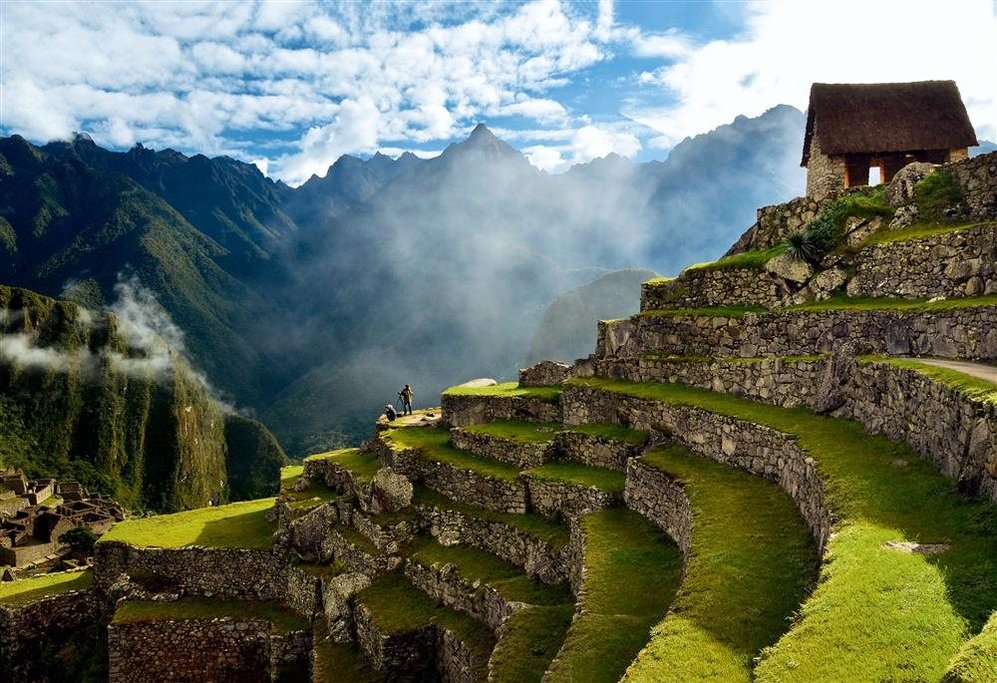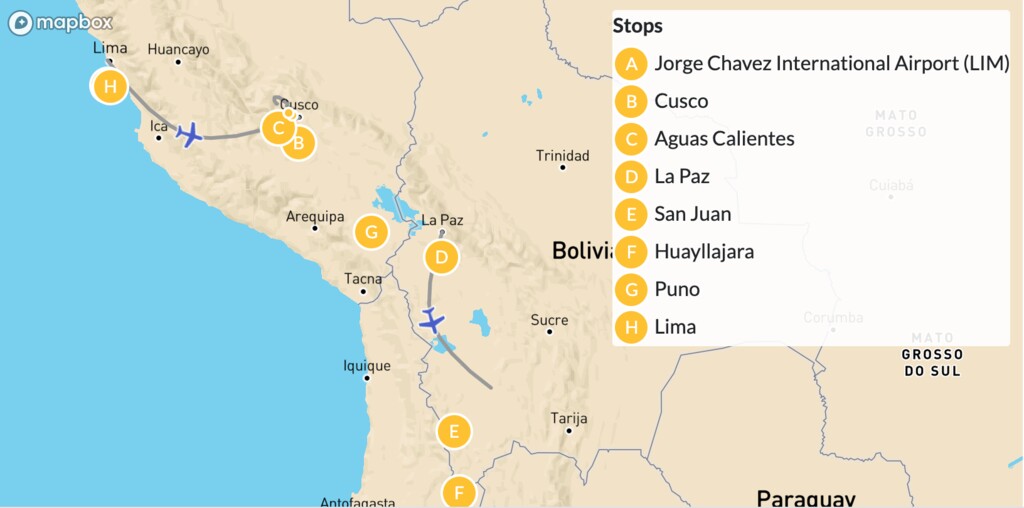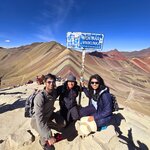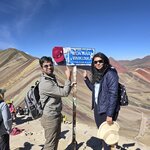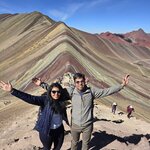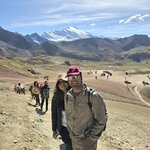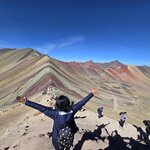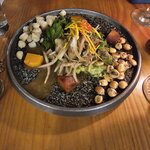Highlights
- Discover ancient Inca ruins and culture in the imperial city of Cusco
- Experience the beauty of the Sacred Valley
- Delve into the secrets of Machu Picchu's ruins
- Visit the Uyuni Salt Flats
- Enjoy a boat ride on Lake Titicaca
Brief Itinerary
| Day | Highlights | Overnight |
|---|---|---|
| Day 1 | Arrive in Lima & Cusco: Free day | Cusco |
| Day 2 | Explore The Sacred Valley & Arrive in Machu Picchu Town: Chinchero, Moray, Maras & Ollantaytambo | Aguas Calientes |
| Day 3 | Visit Machu Picchu: Aguas Calientes - Machu Picchu & Back to Cusco | Cusco |
| Day 4 | Arrive in La Paz & Free Day: Cusco - La Paz | La Paz |
| Day 5 | Uyuni Salt Flats | San Juan |
| Day 6 | Uyuni Salt Flats | Huayllajara |
| Day 7 | Uyuni Salt Flats | La Paz |
| Day 8 | Sun Island By Catamaran & Arrive in Puno | Puno |
| Day 9 | Cultural Sillustani & Llama Trek | Lima |
| Day 10 | Adiós: Depart Peru |
Detailed Itinerary
Day 1: Arrive in Lima & Cusco: Free day

After arriving in Peru in Lima, take a domestic flight onward to Cusco, where you'll be met and transferred to your hotel.
Spend the rest of the day at leisure. Remember that Cusco is at 11,000 feet (3000 m.) above sea level, so take it easy and remember to drink lots of water.
Since Cusco was designed by the Incas as a city for walking, start your exploration of the narrow stone alleyways on foot. Take a gently walk through the plaza; if the weather is beautiful, it's a perfect place to sit on a balcony and have a cup of coca tea while adjusting to the elevation.
Suggested activities:
- Visit the Qoricancha, also known as "The Temple of the Sun." The temple was built by the Incan Emperor Pachacutec (1438 - 1572), and after the arrival of the Spaniards became the basis for the construction of the Santo Domingo Convent.
- Walk to Sacsayhuamán and next-door Quenqo, both archaeological complexes used mostly for religious and agricultural rituals, located 2.5 miles (4 km) from the city of Cusco. Built by the Killke people, Sacsayhuamán is a marvel of ancient architecture, a monolithic fortress built from giant blocks of stone, the origins and assembly of which remain a mystery.
- Discover the elaborate Puca Pucara ruins—an architectural complex of alleged military use with multiple plazas, baths, aqueducts, walls, and towers. It is believed that the entourage of the Incan emperor used it while he stayed at Tambomachay, the elaborate estate and baths nearby.
- Experience the legendary Mercado Central de San Pedro, a large and diverse market famous for its mouth-watering fruit juices, home-style meals, medicinal herb stalls, and rows of various meats, breads, vegetables, and other necessities.
- Eat lunch/dinner at a local Peruvian restaurant and sample local flavors and cooking techniques—crackling pork, pickled vegetables, seasonal flavors, bread baked in earthen ovens, roasted vegetables, and sweet donuts make for a delicious and filling meal.
Day 2: Explore The Sacred Valley & Arrive in Machu Picchu Town: Chinchero, Moray, Maras & Ollantaytambo

This morning you will depart to the town of Chinchero, which the Inca believed to be the birthplace of the rainbow. In this typical Andean village you can see extensive Inca terracing and some pretty colonial-era churches. The town is also known for its weaving studios – you'll have a chance to see the weavers producing handmade products.
From Chinchero you'll continue to Moray, an incredible complex of stone amphitheaters developed by the Inca. While the exact reason for the construction of this site remains unknown, historians believe the Inca constructed in order to experiment with crop production in different micro-climates.
From Moray, you will continue to Salineras of Maras, an incredible patchwork of stone pools and paths developed by the Inca as a means to harvest salt.
In the afternoon, we will go to Ollantaytambo ruins, one of the few remaining places in the Sacred Valley that have retained its original Inca urban planning. Walk through the streets with Inca-era canals and view the ancient houses still in use today. Climb the agricultural terraces where you can enjoy an Inca’s-eye-view of the valley. From the top, you’ll be able to see some of the quarries from where the stone for Ollantaytambo was sourced. It’s amazing to think how far these large stones were transported from, especially considering the Incas didn’t have pack animals strong enough to carry them.
Finally, take the train to Aguas Calientes (Machu Picchu Town) for the overnight.
Day 3: Visit Machu Picchu: Aguas Calientes - Machu Picchu & Back to Cusco

Get an early start to beat the crowds and get the best views of the ancient ruins. From Aguas Calientes, it's an easy 25-minute bus ride up to the Machu Picchu ruins.
This 15th-century Inca citadel is located at 7,970 ft (2,430 m) and is a masterpiece of engineering that served as a sanctuary and retreat for the Incan Emperor Pachacutec and his royal court. Machu Picchu, which means "Old Mountain," is considered a World Heritage Site by UNESCO and is one of the new Seven Wonders of the World.
Built as a seasonal residence for the Inca family, Machu Picchu was rarely home to more than 800 people, and during the royals' absence, a mere 100 servants would remain at the site to maintain the grounds. Machu Picchu was abandoned 100 years after construction and remained largely hidden to the outside world until the early 20th century.
Your guide will lead you around the site and explain the different buildings and curious corners of the building complex. Approximately one-third of the site has been reconstructed into its original structure, giving visitors a sense of the grandeur and artistry of the original citadel.
After the tour, you will have time to explore the citadel on your own, then take the bus back to Aguas Calientes and grab lunch (not included) in the picturesque town center. Connect to your train to Ollantaytambo and your connecting transfer back to your hotel in Cusco.
Day 4: Arrive in La Paz & Free Day: Cusco - La Paz

At the arranged time you will be transferred to the airport for your flight to La Paz.
Upon your arrival in La Paz, you will be escorted to your hotel and have the rest of the day to explore the city by yourself. When you arrive, take note of the city's contrasts, with varying microclimates and architecture styles. While most tourists stay in El Centro, head for the trendy bohemian neighborhood of Sopacachi with an abundance of upscale restaurants, cafés, bars, and nightclubs. It is more expensive than surrounding neighborhoods, but Sopacachi's pedestrian-friendly streets and vibrant cultural scene are worth it.
Suggested activities:
- See the city with the La Paz Cable Cars system: Operating at 4000m (13,000 ft) above sea level, the world’s highest cable car ride has revolutionized the way locals travel between La Paz and neighboring El Alto. A tourist attraction in its own right, the cable cars provide spectacular bird’s-eye views from each of the lines, enabling passengers to grasp just how big and sprawling the city truly is.
- Colorful Calle Jaen: Colored in Spanish Colonial hues of brilliant reds, blues, greens and pinks, walking down Calle Jaén’s narrow cobblestone street feels like stepping back in time.
- El Mercado de las Brujas: More commonly known as The Witches Market. Plenty of Adidas knock-offs to snap up as well as fruit, vegetables, and popcorn.
Chat with a local specialist who can help organize your trip.
Day 5: Uyuni Salt Flats

Early in the morning, you will take your flight to Uyuni. Upon arrival at Uyuni, you will be transferred to the main offices, then take some time for breakfast.
First, you will visit the Train Cemetery to see the first locomotives in Bolivia, then head to Colchani to see handicrafts made of salt, as well as the process of making domestic salt.
From here, you will enter the world’s largest white salt desert. You'll be able to see Ojos del Sal — the outlets for subterranean rivers flowing from the inside, where the salt flat has particular acidic concentrations and is considered medicinal waters by the locals.
Next, you will visit the Salt Hotel, made completely of salt. From here, head to Incahuasi Island (Fish Island), where you will have time for a hike to the top of the island and see the Cactus Valley. Take some time to take fun perspective- and proportion-distorted pictures with the giant cacti and rock formations made of petrified coral. Finally, enjoy sunset before heading back to La Paz.
Day 6: Uyuni Salt Flats

Today you will visit the National Reserve of Andean Fauna Eduardo Avaró.
Start the day with a panoramic view of the Altiplano de Lipez, then continue your way surrounded by volcanoes, such as the Ollague Volcano (5840m). You'll also see some lagoons, including ‘Cañapa’ where you can spot some flamingos, ‘Hedionda’, and ‘Chiarcota’ where you will see a variety of birds and fauna.
From here, enter the Eduardo Avaroa National Reserve and visit the Desert of Siloli (4550m), considered the highest and driest desert in the world. Here, you'll be able to see the Stone Tree and other eroded rock formations. Afterward, you will arrive at the viewpoint of Laguna Colorada – a shallow salt lake with a spectacular setting, with the deep crimson lake a stark contrast to the clear blue sky and the white snow on the distant mountain. Here, you will be able to see three of the world’s six species of flamingo.
Day 7: Uyuni Salt Flats

This day will start early today, around 5:00 a.m. You'll have an early breakfast, then start with a visit to Sol de Mañana Geyser, located at 5,000m. You’ll walk alongside fumaroles and steaming craters filled with boiling pots of mud at 150-200 Cº. Continue to the open-air hot springs of Polques and take a bath in the healing waters.
Afterward, visit the Dali Desert, where Salvador Dali found inspiration for his work from the scattered boulders. Continue to the Green Lagoon, which sits at the foot of the big Licancabur and Juriques volcanoes.
Finally, head back to Uyuni, passing by the Valley of the Rocks, Villamar, and Alota, arriving in Uyuni approximately between 5:00 PM-6:00 PM.
Day 8: Sun Island By Catamaran & Arrive in Puno

Early in the morning around 5:30 AM Bolivia time, transfer to Copacabana Sanctuary for a brief guided visit. At the Copacabana harbor, you will board the Catamaran cruise ship to sail to Sun Island, the birthplace of the Inca Empire. In this legendary island, you will visit the Inca Garden, Stairs, and Fountain.
The itinerary continues with a visit to the Inti Wata Cultural Complex which includes two underground Museums of Archeology and Anthropology, the Traditional Medicine and the Titikaka Reed Shipbuilders Display Centers, the Pachamama Agricultural Inca Terraces, a handicraft display, the Intica Lounge, and an exhibit of a variety of Andean camelids. The Inti Wata Complex is the main tourist attraction in Bolivia and includes a unique sailing experience onboard a huge Titicaca traditional reed vessel for a panoramic visit to the Pilkokaina Inca Palace.
Afterward, board the Catamaran cruise again to sail back to Copacabana while enjoying a buffet lunch. From here, you'll transfer by land to the city of Puno, arriving around 7:00 PM.
Day 9: Cultural Sillustani & Llama Trek

Start the day early, setting off on a scenic drive to Atuncolla, accompanied by llamas as you walk through the lonely Andean landscape until you arrive at the light blue shimmering lagoon of Uyumayo. Cross the beautiful lagoon in traditional boats to reach the Necropolis Sillustani. The dead city from the Pre-Inka period houses 90 monoliths that stand up to 15 meters high, built of volcanic stone tombs.
Enjoy the unique panorama of the ancient tomb overlooking the Andes and the beautiful lagoon as the tour guide takes you through the necropolis and teaches you about the Inca and Aymara culture.
Afterward, head to Juliaca Airport for your flight to Lima.
Day 10: Adiós: Depart Peru

Today is your last day in Peru! You will be met at your hotel for a transfer to the airport, where you will catch your international departure.
¡Buen viaje!
